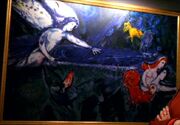
Adam and Eve cast out of paradise
According to the Bible of the Jewish and Christian religion, the Garden of Eden was the habitat created by God for the first Humans, Adam and Eve. They would later be cast from the Garden of Eden after succumbing to temptation of the Devil and disobeying God's law. In common parlance, Eden became a symbolic word for paradise.
In 2267, Spock, under the influence of Omicron spores, claimed that the spores had turned Omicron Ceti III into "a true Eden." (TOS: "This Side of Paradise")
Soon after, Pavel Chekov inaccurately believed that the Garden of Eden was located "just outside Moscow." He claimed that it was "a very nice place" and that "it must've made Adam and Eve very sad to leave." (TOS: "The Apple")
In 2268, James T. Kirk metaphorically called the planet Neural a Garden of Eden. He also referred to introducing flintlocks to the Neural natives as introducing serpents to the Garden of Eden. (TOS: "A Private Little War")
In 2293, Spock kept a piece of 20th century Earth art called "Adam and Eve Expelled from Paradise", painted by noted artist Marc Chagall, in his quarters. The painting depicts a scene of Adam and Eve being cast out of the Garden of Eden. For Spock the painting was a reminder that "all things end." (Star Trek VI: The Undiscovered Country)
In 2364, Luisa Kim, a terraformer on Velara III, referred to herself as a "Gardener of Edens". (TNG: "Home Soil")
In 2374, in describing Bajor to William Ross, Benjamin Sisko compared parts of the Eastern Province to being like Eden itself. (DS9: "Favor the Bold")
